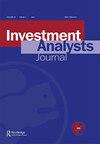预测保险股超额收益的改进:投资者情绪承受指数与CAPM和Fama-Franch模型的比较
IF 2.2
4区 经济学
Q3 BUSINESS, FINANCE
引用次数: 3
摘要
摘要本研究运用何(2012)提出的情绪承受能力(SE)指数对保险股超额收益进行预测。除了Fama French三因素模型(FF)的12个月滚动预测外,SE模型的预测在较低的绝对百分比预测误差(APFE)和显著较低的APFE标准差方面始终优于CAPM和FF模型。SE模型的6个月滚动预测精度明显高于FF模型。此外,本研究发现,在SE模型中包含SMB和HML会显著降低预测的准确性和稳定性。在较小程度上,在SE模型中添加市场风险因素对预测质量的影响大于提高。研究结果清楚地表明,与全球变量相比,SE指数作为一个局部变量,更准确地反映了保险投资者的情绪和对新闻的反应,因此可以更好地预测保险股的超额收益。本文章由计算机程序翻译,如有差异,请以英文原文为准。
Improvements in forecasting insurance stock excess returns: Comparing the investor sentiment endurance index with the CAPM and Fama-French models
ABSTRACT This study applies the sentiment endurance (SE) index developed by He (2012) to forecast excess returns of insurance stocks. With the exception of the 12-month rolling forecasts of the Fama-French three-factor model (FF), forecasts of the SE model persistently outperform that of the CAPM and FF models in terms of lower absolute percent forecasting error (APFE) and significantly lower standard deviation of APFE. The accuracy of 6-month rolling forecasts of SE model is significantly higher than that of the FF model. Further, this study finds that the inclusion of SMB and HML in the SE model significantly deteriorates the accuracy and stability of forecasts. To a lesser degree, the addition of the market risk factor to the SE model hurts more than it improves the quality of forecasts. The results clearly suggest that compared to global variables, the SE index, as a local variable, more accurately reflects insurance investor sentiment and response to news and therefore can better forecast excess returns of insurance stocks.
求助全文
通过发布文献求助,成功后即可免费获取论文全文。
去求助
来源期刊

Investment Analysts Journal
BUSINESS, FINANCE-
CiteScore
1.90
自引率
11.10%
发文量
22
期刊介绍:
The Investment Analysts Journal is an international, peer-reviewed journal, publishing high-quality, original research three times a year. The journal publishes significant new research in finance and investments and seeks to establish a balance between theoretical and empirical studies. Papers written in any areas of finance, investment, accounting and economics will be considered for publication. All contributions are welcome but are subject to an objective selection procedure to ensure that published articles answer the criteria of scientific objectivity, importance and replicability. Readability and good writing style are important. No articles which have been published or are under review elsewhere will be considered. All submitted manuscripts are subject to initial appraisal by the Editor, and, if found suitable for further consideration, to peer review by independent, anonymous expert referees. All peer review is double blind and submission is via email. Accepted papers will then pass through originality checking software. The editors reserve the right to make the final decision with respect to publication.
 求助内容:
求助内容: 应助结果提醒方式:
应助结果提醒方式:


